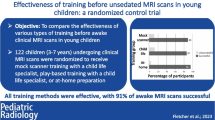Abstract
Background
Pediatric magnetic resonance imaging (MRI) can be stressful. Mock MR scanners have been proven to be effective in avoiding the use of general anesthesia.
Objectives
We prospectively evaluated the impact of a teddy bear-scale model of a mock MR scanner on the anxiety experienced by parents and their children during MRI without general anesthesia .
Materials and methods
A 1-year prospective study before and after the installation of a mock scanner in a Pediatric Radiology Department of a university hospital. Anxiety levels were self-estimated by children ages 4 to 16 years and by the parents with a visual analogue scale (from 0, completely relaxed, to 100, extremely stressed) at three moments: in the waiting room, in the preparation room after an explanation by the MRI technologists, and at the issue of the MR acquisition images. Two groups were tested: one with a mock MR scanner, the other without. Analysis of variance (ANOVA) and Fisher exact tests were performed. Motion artifacts were studied.
Results
Ninety-one children and their parents were included. The median age was 8 years (standard deviation [SD]=2). In the post mock period, the ambiance of the preparation room was considered by children as significantly more relaxing in 50% vs. 20% (P=0.004) and the anxiety level of children was significantly lower after the explanation, particularly in girls, but unchanged for their parents. The anxiety levels at the end of the examination were significantly lower for parents. The motion artifacts rate was lower (1.7% vs. 4.7%, P=0.04).
Conclusion
A mock scanner was an efficient tool to improve efficiency of the explanation and to decrease anxiety in children and motion artifacts in pediatric MRI.




Similar content being viewed by others
References
Tyc VL, Fairclough D, Fletcher B et al (1995) Children’s distress during magnetic resonance imaging procedures. Child Health Care 24:5–19
Marshall SP, Smith MS, Weinberger E (1995) Perceived anxiety of pediatric patients to magnetic resonance. Clin Pediatr (Phila) 34:59–60
American Society of Anesthesiologists Task Force on sedation and analgesia by non-anesthesiologists (2002) practice guidelines for sedation and analgesia by non-anesthesiologists. Anesthesiology 96:1004–1017
Sury M, Bullock I, Rabar S et al (2010) Sedation for diagnostic and therapeutic procedures in children and young people: summary of NICE guidance. BMJ 341:c6819
Cejda KR, Smeltzer MP, Hansbury EN et al (2012) The impact of preparation and support procedures for children with sickle cell disease undergoing MRI. Pediatr Radiol 42:1223–1228
Cahoon GD, Davison TE (2014) Prediction of compliance with MRI procedures among children of ages 3 years to 12 years. Pediatr Radiol 44:1302–1309
Cravero JP, Beach ML, Blike GT et al (2009) The incidence and nature of adverse events during pediatric sedation/anesthesia with propofol for procedures outside the operating room: a report from the pediatric sedation research consortium. Anesth Analg 108:795–804
Sanborn PA, Michna E, Zurakowski D et al (2005) Adverse cardiovascular and respiratory events during sedation of pediatric patients for imaging examinations. Radiology 237:288–294
Edwards AD, Arthurs OJ (2011) Paediatric MRI under sedation: is it necessary? What is the evidence for the alternatives? Pediatr Radiol 41:1353–1364
Bratton SC, Ray D, Rhine T, Jones L (2005) The efficacy of play therapy with children: a meta-analytic review of treatment outcomes. Prof Psychol Res Pract 36:376–390
Russell C, Smart S (2007) Guided imagery and distraction therapy in paediatric hospice care. Paediatr Nurs 19:24–26
Hartman JH, Bena J, McIntyre S, Albert NM (2009) Does a photo diary decrease stress and anxiety in children undergoing magnetic resonance imaging? A randomized, controlled study. J Radiol Nurs 28:122–128
Tyc VL, Leigh L, Mulhern RK et al (1997) Evaluation of a cognitive-behavioral intervention for reducing distress in pediatric cancer patients undergoing magnetic resonance imaging procedures. Int J Rehabil Health 3:267–279
Hallowell LM, Stewart SE, de Amorim E et al (2008) Reviewing the process of preparing children for MRI. Pediatr Radiol 38:271–279
de Bie HMA, Boersma M, Wattjes MP et al (2010) Preparing children with a mock scanner training protocol results in high quality structural and functional MRI scans. Eur J Pediatr 169:1079–1085
Carter AJ, Greer ML, Gray SE, Ware RS (2010) Mock MRI: reducing the need for anaesthesia in children. Pediatr Radiol 40:1368–1374
R Foundation (2015) R: A language and environment for statistical computing. Vienna, Austria; 2014. http://www.r-project.org (Accessed 7 August 2019)
Acknowledgments
We thank the participating children and their families, all the MRI technologists at Tours University Hospital Center and Elodie Gaspard. We are especially grateful to Elodie Semelier and Marie Claude Santini from the Pharmavie Association and Laura Elharrar.
Author information
Authors and Affiliations
Corresponding author
Ethics declarations
Conflicts of interest
None
Additional information
Publisher’s note
Springer Nature remains neutral with regard to jurisdictional claims in published maps and institutional affiliations.
Rights and permissions
About this article
Cite this article
Morel, B., Andersson, F., Samalbide, M. et al. Impact on child and parent anxiety level of a teddy bear-scale mock magnetic resonance scanner. Pediatr Radiol 50, 116–120 (2020). https://doi.org/10.1007/s00247-019-04514-1
Received:
Revised:
Accepted:
Published:
Issue Date:
DOI: https://doi.org/10.1007/s00247-019-04514-1




